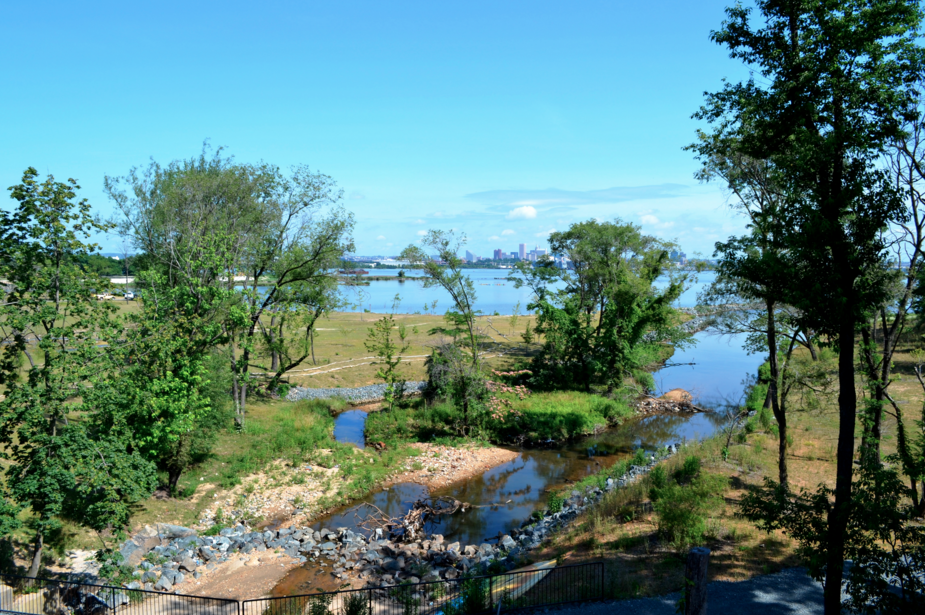
In 2013, the U.S. Fish and Wildlife Service announced the first Urban Wildlife Refuge Partnership in the country: Masonville Cove, a reclaimed 54-acre site on the southern edge of the Patapsco River near the city neighborhood of Brooklyn.
Today, as part of a White House-organized, daylong environmental roundtable at the People and Parks Foundation in West Baltimore, the U.S. Fish and Wildlife Service announced it is expanding that partnership to include the Middle Branch watershed throughout South and West Baltimore. The goal is to bring the city, environmental organizations, and neighborhood groups together with the Fish and Wildlife Service to rebuild community green spaces, improve water quality, and create wildlife habitats while encouraging local environmental stewardship.
The effort does not include the federal purchase of land for protected purposes—or immediate funding—but does represent a broader shift at U.S. Fish and Wildlife toward more urban-focused work.
“The population is becoming more urbanized in the country,” says Chris Guy, with the Chesapeake Bay office of the U.S. Fish and Wildlife Service. “And one thing we want to do is, rather than people come to us [at federally protected lands], is connect the public with nature up close and personal in their own neighborhood, which in many cases, has been lost.”
The expanded U.S. Fish and Wildlife watershed designation was just one of the new federal-local initiatives announced by the White House, however.
The city, working with the USDA, will launch Baltimore’s first permanent “GROW” (Green Resources and Outreach for Watersheds) Center, where residents and community leaders can access free/low cost materials as well as gather practical education on managing storm water and revitalizing vacant lots—whether for park or garden space or another use. The project comes on the heels of a “pop-up” GROW center effort last spring at Baltimore Community ToolBank in Southwest hosted by the City Office of Sustainability.
The EPA and U.S. Forest Service, along with the National Fish and Wildlife Foundation and CSX Corporation, have also come together to fund schoolyard habitats at 10 schools across the city. The flagship project will start at Green Street Academy, in the renovated Gwynns Falls Junior High School, in West Baltimore. The project, according to the White House, will also engage 20 teachers and 10 facilities managers at a series of workshops to learn about the benefits of taking action to improve habitat and water quality.
The EPA and the U.S. Geological Survey will also be launching a partnership with Blue Water Baltimore and the Waterfront Partnership to install new technology on the Inner Harbor’s popular “Mr. Trash Wheel” that will provide online, real-time water quality data for community and business leaders and environmental advocates—as part of a clean water outreach and education effort.
The Friday roundtable at People and Parks was scheduled to include presentations by Blue Water Baltimore, the Waterfront Partnership, the Chesapeake Conservancy, and the Chesapeake Center for Youth Development, as well as various city, state, and federal agencies involved in a variety of Baltimore City environmental issues.
One other initiative—with $75,000 in seed money from the National Park Service and the Maryland Department of Natural Resources—will help the Baltimore City Department of Recreation & Parks begin the development a new comprehensive plan for the city’s park system – the first such plan since 1926.
One of the ideas behind the environmental roundtable is for local, state, and federal agencies and environmental leaders to update each other on the issues they’ve been tackling. But also to look forward at what issues should be addressed in the next five and 10 years. “I think we’ll be looking at what is the next mission, what is the next major project,” says Adam Lindquist, director of Healthy Harbor Initiative.
The event, designed to foster collaboration among various stakeholders already working on environmental issues, grew out of a broader White House Task Force on Baltimore that was formed in the aftermath of the riot last year. Baltimore-native Nate Loewentheil, a senior policy advisor at the National Economic Council, is heading up task force, which largely has focused on more purely economic issues thus far, such as jobs, housing, and youth employment. “You can’t cleanup the harbor without cleaning up the surrounding city,” says Loewentheil, explaining the White House’s interest in Baltimore’s steep environmental challenges. “And, in order to attract new economic activity and investment,” he adds, “the city needs livable, sustainable, healthy neighborhoods.”
Though not directly related to roundtable announcements today, a new collaboration between the Fish and Wildlife Service and the City Department of Recreation and Parks led to an urban bird “treaty” earlier this month, which will help create habitat in the Gwynns Falls/Leakin Park are for migratory birds.
